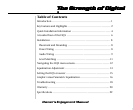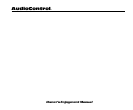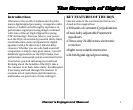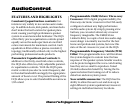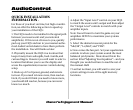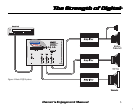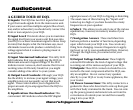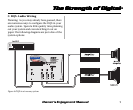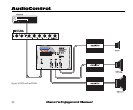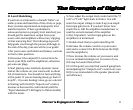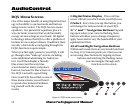
Owner’s Enjoyment Manual
AudioControl®
FEATURES AND HIGHLIGHTS
Constant-Q equalization controls: Car
interiors vary widely in size and acoustic make-
up. In addition doors, kick-panels, and rear decks
don’t make the best location for speaker place-
ment causing your high performance speaker
system to sound somewhat lackluster. The DQX
offers thirty precise equalization controls spread
equally across the audio spectrum at one-third
octave increments for maximum control. Each
equalization filter utilizes a precise constant-Q
topology, traditionally utilized only in the highest
performing professional audio products.
Parametric Equalization Controls: In
addition to the thirty, one-third octave controls,
the DQX also offers two, fully-adjustable paramet-
ric equalization controls. With the DQX’s para-
metric controls you select a center frequency, dial
in the ideal bandwidth and apply the appropriate
amount of boost or cut. The precise filtering of the
DQX allows you to select bandwidths as narrow as
1/12 octave!
Programmable 24dB/Octave Three-way
Crossover: With digital programmability, the
three-way electronic crossover in the DXS easily
configures to almost any high-performance
mobile audio system. By simply pressing a few
buttons, you can select almost any crossover
frequency imaginable. The 24dB/Octave
Linkwitz-Riley (a couple of real nice audio engi-
neers) design is normally reserved for the best
home and professional systems, but now this
state-of-the-art crossover is yours in the DQX.
Programmable Frequency Match (PFM)
Filter: This programmable low cut filter allows
the system designer to custom tune the bass
response of the speaker system. Smaller woofers
can be protected against the voice-coil-charring
bass they are too small to reproduce. Tuned
(Ported) subwoofers benefit by having the fre-
quencies below their tuning cut off to reduce
distortion and save system power.
Non-volatile memories: The DQX has the
ability to allow the user to set and store up to
eight different system (equalization/crossover)
settings in individual memory locations.
2





